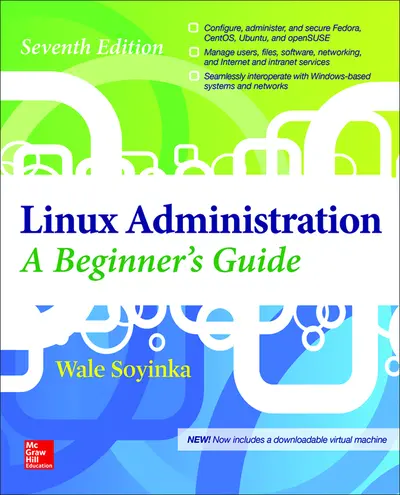My Account Details

ISBN10: 0071845372 | ISBN13: 9780071845373

Step 1 . Download Adobe Digital Editions to your PC or Mac desktop/laptop.
Step 2. Register and authorize your Adobe ID (optional). To access your eBook on multiple devices, first create an Adobe ID at account.adobe.com. Then, open Adobe Digital Editions, go to the Help menu, and select "Authorize Computer" to link your Adobe ID.
Step 3. Open Your eBook. Use Adobe Digital Editions to open the file. If the eBook doesn’t open, contact customer service for assistance.
Now with a virtual machine showcasing the book's test system configuration, Linux Administration: A Beginner's Guide, Seventh Edition teaches system administrators how to set-up and configure Linux quickly and easily.
Effectively set up and manage any version of Linux on individual servers or entire networks using this practical resource. Fully updated to cover the latest tools and techniques, Linux Administration: A Beginner’s Guide, Seventh Edition features clear explanations, step-by-step instructions, and real-world examples. Find out how to configure hardware and software, work from the GUI or command line, maintain Internet and network services, and secure your data. Performance tuning, virtualization, containers, software management, and backup solutions are covered in detail.
• Install and configure Linux, including the latest distributions from Fedora, Ubuntu, CentOS, openSUSE, Debian, and RHEL
• Manage users, permissions, files, folders, and applications
• Set up and administer system services and daemons
• Manage software from source code or binary packages
• Customize, build, or patch the Linux kernel
• Work with physical and virtual file systems, such as proc, SysFS, and cgroup
• Understand networking protocols, including TCP/IP, ARP, IPv4, and IPv6
• Build reliable firewalls and routers with Netfilter (iptables and nftables) and Linux
• Monitor and test network activity and minimize security threats
• Create and maintain DNS, FTP, web, e-mail, print, LDAP, and VoIP servers
• Share resources using GlusterFS, NFS, and Samba
• Implement popular cloud-based technologies using Linux virtualization and containers using KVM and Docker
Chapter 1: Technical Summary of Linux Distributions
Chapter 2: Installing Linux in a Server Configuration
Chapter 3: Managing Software
Part II: Single-Host Administration
Chapter 4: Managing Users and Groups
Chapter 5: The Command Line
Chapter 6: Booting and Shutting Down
Chapter 7: File Systems
Chapter 8: Core System Services
Chapter 9: The Linux Kernal
Chapter 10: Knobs and Dials: Virtual File Systems
Part III: Networking and Security
Chapter 11: TCP/IP for System Administrators
Chapter 12: Network Configuration
Chapter 13: Linux Firewall
Chapter 14: Local Security
Chapter 15: Network Security
Part IV: Internet Services
Chapter 16:DNS
Chapter 17: FTP
Chapter 18: Apache Web Server
Chapter 19: SMTP
Chapter 20: POP and IMAP
Chapter 21: Voice Over IP
Chapter 22: The Secure Shell
Part V: Intranet Services
Chapter 23: Network File System
Chapter 24: Samba
Chapter 25: Distributed File Systems
Chapter 26: Network Information Service
Chapter 27: LDAP
Chapter 28: Printing
Chapter 29: DHCP
Chapter 30: Virtualization
Chapter 31: Backups
Part VI: Appendixes
Appendix A: Creating a Linux Installer on Flash/USB Devices
Appendix B: OpenSUSE Installation
Need support? We're here to help - Get real-world support and resources every step of the way.